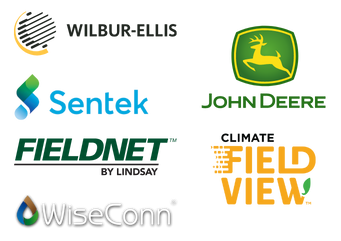Best-in-class aerial imagery
When it comes to imagery for agriculture, Ceres customers have the proven advantage
Unlike other providers, Ceres controls our aerial imagery process from start to finish—from data capture with camera units purpose-built in-house, to proprietary processing techniques and expert analysis. Full control allows us to offer unrivaled quality, while our proven pipeline and global team ensure delivery within 48 hours.
Our core data layers
We’re the industry leader in high-resolution multispectral imagery built specifically for agriculture. Our customers benefit from our rigorous attention to detail at every step—from data capture to imagery delivery.
 Chlorophyll Index
Chlorophyll Index
By measuring reflectances in multiple visible and near infrared bands, our Chlorophyll Index provides insights into plant nitrogen content in-season. More sensitive to nutrient differences than NDVI imagery, the Chlorophyll Index informs targeted tissue sampling, early yield predictions in row crops, and fertility management.
 Color infrared
Color infrared
Color infrared (CIR) imagery incorporates near infrared (NIR), green, and red reflectances, resulting in a clearer display of vegetation and soil than RGB color imagery. Growers use CIR imagery for early-season monitoring of emergence, canopy density, and soil composition or water content.
 Thermal
Thermal
Unlike similar products derived from satellite data, scientific-grade imagery from our plane-mounted thermal cameras reveals minute differences in temperature at a plant level. Ceres Imaging can accurately detect temperature differences of 0.1 degree Celsius between plants, with an absolute accuracy within 1 degree Celsius—the most accurate thermal imagery available for agriculture.
INTEGRATIONS
Ceres Imaging integrates seamlessly with farm management software and in-field sensors.

Ensuring accuracy
Ceres Imaging’s emphasis on quality begins even before we fly your fields.
Image capture
We capture imagery during peak daylight hours and under weather conditions that minimize distortion from shadows and cloud cover. Our highly sensitive, custom-built cameras detect minute changes in the multispectral range—allowing us to detect crop stress earlier than our competitors.
Processing and analysis
Imagery is geo-referenced and meticulously “masked” to ensure that only relevant information is evaluated. By making use of crop-specific data models and isolating the canopy from ground cover and other background noise, we prevent skewing of the data and enable a more accurate assessment of plant health.
Quality control
Imagery is assessed in-house by Ceres Imaging’s remote sensing experts, passing through multiple checkpoints before delivery in the Ceres Imaging app within 48 hours of the flight. Growers can access their data on a mobile device, tablet, or desktop computer.
The difference between Ceres AI and other technologies I've used is the help I get from their expert team.
With Ceres AI we can take a more targeted approach to applying fertilizer and nutrients.
These flights can cover way more ground and provide more insight than a dozen soil moisture probes — and it's cheaper to implement.
The average Ceres AI conductance measurement from its imagery over the season has provided the best correlation with applied water.



 NDVI
NDVI

 Water Stress Index
Water Stress Index




